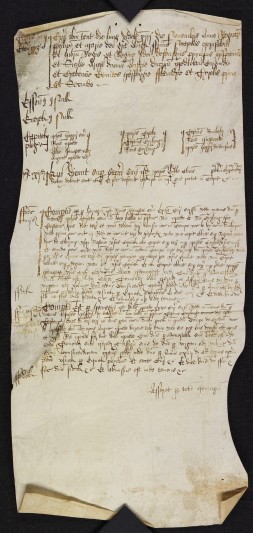Clavering is a small parish in high North-West Essex, once the tiny capital of the Half-Hundred of Clavering but now known mainly for picturesque views and for a certain celebrity chef.
The leading manor was the Manor of Clavering, associated with the remains of an early castle. Curles was one of two smaller manors, its moated manor house lying about half a mile from the village centre. The ownership of these manors is slightly obscure, but they seem to have been held generally by the Barlee family of minor local gentry. The last of their line died at Curles in 1757. At the period of these rolls, however, the family seem to have been in some distress: they sold the reversion of one manor in 1568, and in 1563 a lease of Curles itself had been granted to a local yeoman by one Margaret Fulvelbye, a Cambridgeshire widow. The lease specifically excluded the profits of this manor court.
The records present themselves as eight rolls, each relating to a single sitting of the court. However, since each ‘roll’ is a single membrane and they bear old sewing holes at the top it is likely that they once formed a single document. It cannot be proved that there were not other intervening courts, although long intervals between sittings might not be unusual in a small manor.
An unexpected feature is that five of the rolls are on paper and only three on parchment. Evidently the choice was not random, for the paper rolls all preceded the parchment ones, overturning the common assumption that paper drives out parchment. Parchment in fact remained the normal material for court rolls long after this date. The scrappy form of the paper rolls suggests that they are drafts, waiting to be replaced by parchment fair copies in a due course that never arrived.
The rolls in fact show clearly why parchment held its place for so long. The paper sheets are torn and tattered at the edges, with some damage by damp, and they will need conservation before they can be handled safely. A twisting worm hole runs through most of them. The parchments, on the other hand, are in fine condition. Still present are two parchment patches, added on the reverse to cover natural holes in the skins and then overwritten.
Although the rolls cover a tumultuous period in English history they contain no word of events beyond the manor itself. Whatever may have been happening in the national sphere it did not disturb the rhythms of the court. Its records form a unique source of material for local history, and especially for the manorial tenants and their holdings. The rolls join other, later, records of the manor already held by the Essex Record Office. We are grateful to the Friends, to our own Friends of Historic Essex and to the Clavering History Group for enabling us to preserve them locally.
